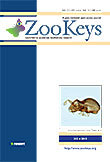Ver ítem
- xmlui.general.dspace_homeCentros Regionales y EEAsCentro Regional Catamarca - La RiojaEEA ChilecitoArtículos científicosxmlui.ArtifactBrowser.ItemViewer.trail
- Inicio
- Centros Regionales y EEAs
- Centro Regional Catamarca - La Rioja
- EEA Chilecito
- Artículos científicos
- Ver ítem
Revision of the family Carabodidae (Acari, Oribatida) XII. Yoshiobodes camerunensis sp. n. and Rugocepheus costaricensis sp. n.
Resumen
Yoshiobodes camerunensis sp. n., collected in Cameroon, is the first species of this genus reported from the Afrotropical region. Diagnostic characters include lamellae terminating in a bridge and not in lamellar tips; cup-shaped bothridia, bothridial ring present; rostral setae cochleariform, smooth; lamellar setae slightly lanceolate, barbate; fifteen pairs of notogastral setae; c3 lanceolate, rounded end, with longitudinal shallow grooves; other
[ver mas...]
Yoshiobodes camerunensis sp. n., collected in Cameroon, is the first species of this genus reported from the Afrotropical region. Diagnostic characters include lamellae terminating in a bridge and not in lamellar tips; cup-shaped bothridia, bothridial ring present; rostral setae cochleariform, smooth; lamellar setae slightly lanceolate, barbate; fifteen pairs of notogastral setae; c3 lanceolate, rounded end, with longitudinal shallow grooves; other notogastral setae curved lanceolate-cochleariform. Rugocepheus costaricensis sp. n. is the third species of the genus to be described, and the first collected outside the African region. Prodorsum presents a Y-shaped structure; elevated interlamellar process, superior flat zone; lamellae lacking lamellar tips; fourteen pairs of notogastral setae; four notogastral furrows, and an unpaired elevated central area devoid of setae. Both species are described and illustrated based on adult specimens, studied by means of optical and SEM microscopy.
[Cerrar]

Autor
Fernandez, Nestor;
Theron, Pieter Daniel;
Leiva, Sergio Dante;
Tiedt, Louwrens;
Fuente
ZooKeys 706 : 31-50 (October 2017)
Fecha
2017-10
Editorial
Pensoft Publishers
ISSN
1313-2989
1313-2970
1313-2970
Formato
pdf
Tipo de documento
artículo
Palabras Claves
Derechos de acceso
Abierto
 Excepto donde se diga explicitamente, este item se publica bajo la siguiente descripción: Creative Commons Attribution-NonCommercial-ShareAlike 2.5 Unported (CC BY-NC-SA 2.5)
Excepto donde se diga explicitamente, este item se publica bajo la siguiente descripción: Creative Commons Attribution-NonCommercial-ShareAlike 2.5 Unported (CC BY-NC-SA 2.5)


